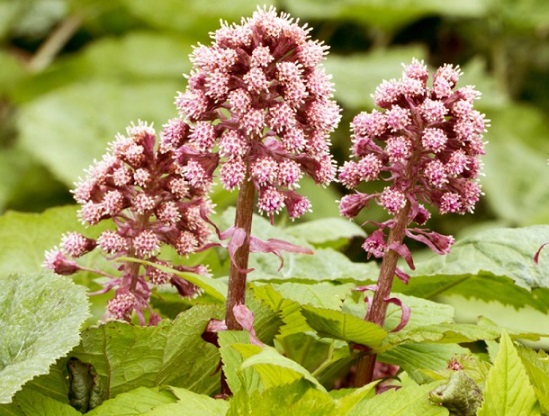S-Petasin Activates the Nrf2 Signalling Pathway to Protect Retinal Cells from Damage Due to Oxidative Stress
Nikhil Prasad Fact checked by:Thailand Medical News Team Feb 05, 2025 2 months, 1 week, 1 day, 1 hour, 57 minutes ago
Medical News: The retinal pigment epithelium (RPE) plays a crucial role in maintaining eye health by acting as a barrier and providing metabolic support to photoreceptor cells. However, oxidative stress, caused by an overproduction of reactive oxygen species (ROS), can lead to cellular damage and degenerative eye diseases such as age-related macular degeneration (AMD). To combat this issue, researchers are exploring natural compounds with antioxidant properties that can help protect the RPE from oxidative stress.
 S-Petasin Activates the Nrf2 Signalling Pathway to Protect Retinal Cells from Damage Due to Oxidative Stress
S-Petasin Activates the Nrf2 Signalling Pathway to Protect Retinal Cells from Damage Due to Oxidative Stress
Image: Petasites hybridus plant from which the phytochemical S-Petasin is extracted.
A recent study conducted by Italian researchers from Università Cattolica del Sacro Cuore, Fondazione Policlinico Universitario Agostino Gemelli IRCSS, UniCamillus-Saint Camillus International University of Health Sciences, the University of Palermo, and Istituto di Scienze e Tecnologie Chimiche “Giulio Natta” SCITEC-CNR has investigated the protective effects of S-Petasin, a phytochemical compound derived from the plant Petasites hybridus. This
Medical News report explores the potential of S-Petasin in preventing oxidative stress-induced retinal damage.
How S-Petasin Protects Retinal Cells
The study focused on determining whether S-Petasin could shield retinal cells from oxidative stress. Researchers exposed human RPE cells (ARPE-19) to hydrogen peroxide (H2O2) to induce oxidative damage, simulating the conditions that lead to retinal degeneration. They then pretreated the cells with S-Petasin and measured the effects on cell viability, intracellular ROS levels, and activation of the nuclear factor erythroid 2-related factor (Nrf2) pathway.
Key findings from the study include:
-Reduction of Oxidative Stress: S-Petasin significantly reduced intracellular ROS levels, indicating its antioxidant properties. The compound prevented excessive oxidative stress from damaging retinal cells.
-Activation of Nrf2 Signalling: The Nrf2/KEAP1 pathway plays a critical role in the body's response to oxidative stress. The study found that S-Petasin increased intracellular Nrf2 levels in stressed cells, leading to the activation of antioxidant genes that protect against cellular damage.
-Regulation of Apoptosis: Oxidative stress can trigger apoptosis (programmed cell death), contributing to retinal degeneration. The researchers observed that S-Petasin reduced the levels of the pro-apoptotic protein Bax while increasing the anti-apoptotic protein Bcl-2, thus enhancing cell survival.
-Modulation of Antioxidant Biomarkers: The study found that S-Petasin improved the balance of key antioxidant biomarkers, including increased glutathione (GSH) levels and reduced malondialdehyde (MDA) concentrations, further supporting its protecti
ve effects.
Potential Implications for Eye Health
The findings suggest that S-Petasin could serve as a promising natural supplement to enhance the eye’s resistance to oxidative stress. By activating the Nrf2 pathway, it helps maintain the delicate balance required for RPE cell survival, which is essential in preventing conditions like AMD. Unlike traditional antioxidant treatments, which may only neutralize ROS, S-Petasin appears to enhance the body's intrinsic defense mechanisms, making it a potential long-term protective strategy.
Conclusion
This study provides valuable insight into the protective effects of S-Petasin against oxidative stress-induced retinal damage. By reducing oxidative stress, activating the Nrf2 pathway, and modulating apoptosis-related proteins, S-Petasin demonstrates significant potential in eye health research. However, further studies, including clinical trials, are necessary to determine its full therapeutic potential and optimal dosages for human use. As natural compounds continue to gain attention for their health benefits, S-Petasin may emerge as a key player in future ophthalmic treatments.
The study findings were published in the peer-reviewed journal: Antioxidants.
https://www.mdpi.com/2076-3921/14/2/180
For the latest on Herbs and Phytochemical, keep on logging to Thailand
Medical News.
Read Also:
https://www.thailandmedical.news/news/brazilian-study-finds-that-ouabain-counteracts-retinal-ganglion-cell-death
https://www.thailandmedical.news/news/murine-study-finds-that-resveratrol-protects-against-retinal-degeneration
https://www.thailandmedical.news/news/cobalt-protoporphyrin-and-its-potential-to-counter-hyperglycemia-induced-retinal-damage
https://www.thailandmedical.news/news/covid-19-causes-long-term-retinal-health-issues
